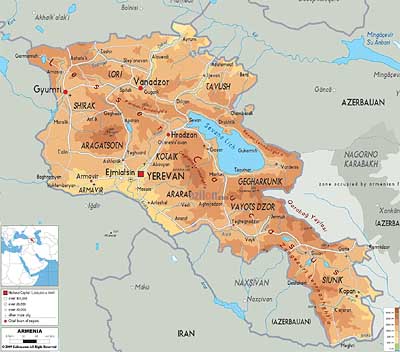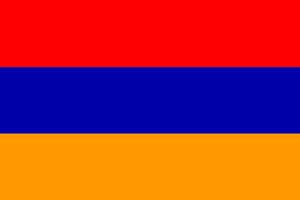-
- Armenian Map
|
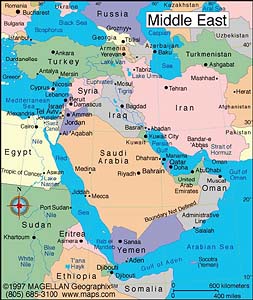 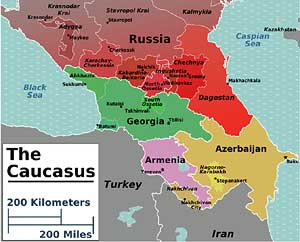 -
- Mid-East Map
Caucasus Map
|
|
-
|
- latest picture: July 7, 2013
|
| July
2nd, 2013: “Tourists?” asks us the immigration officer at the border
post of Bagratashen, when we hand him over our new passports that we
just received the other day from our Swiss Embassy in Tbilisi/Georgia.
When we confirm he quickly adds: “Welcome to Armenia”. He chops the
entry stamp on the last page next to the Georgian exit. A few steps
away, a customs officer is already waiting. He asks the same question,
opens quickly each door and sends us to the hangar next door. “Well, now
it seems that we have to unload – since New Zealand, 5½ years ago, the
first time”, I worriedly say to Emil. |
-
-
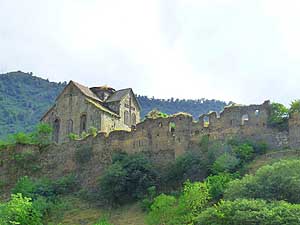
|
-
-
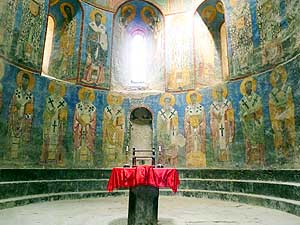
|
-
-
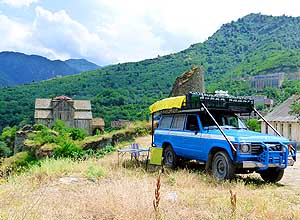
|
- 001
Armenia is known for its many
- monasteries. 15 miles from the north-
- easterly border post of Bagratashen
- lies the Akhtale Monastary from the
- 13th century, situated at the edge
- of the same named village .....
|
- 002
..... it is mainly appreciated for
- its fine frescoes. The almost surreal
- power of the coloring is characteristic
- of typical Byzantine art while the
- themes are more Armenian
|
- 003
The setting on a high plateau
- and the peace surrounding the fortress
- church of Akhtale make it an ideal
- spot for a relaxed picnic
|
|
Cheerful chirping of birds greets us at the hangar. Swallows fly busily
in and out. Glancing at the ceiling I can hardly believe my eyes.
Swallow’s nests made of soil stick side by side. I count 30 being still
intact. But crumbled ones give evidence that there were many more. From
tiny slits little black heads appear once in a while. The sight is so
heartening that I spontaneously declare this border crossing to be my
loveliest ever – it is our 490th altogether! |
-
-
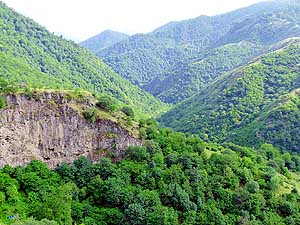
|
-
-
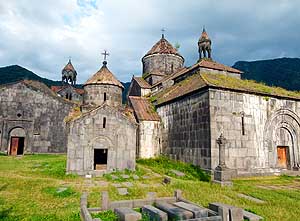
|
-
-
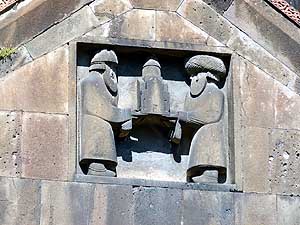
|
- 004
After Akhtale we drive through
- green forested hills to the next
- “sacred building” .....
|
- 005
..... the Haghpat Monastery,
- situated on a lofty plateau only 8 miles
- further on. It is praised as pearl of a
- monastery and was given UNESCO
- World Heritage status .....
|
- 006
..... in its bright stone walls there
- are niches with beautiful reliefs of Smbat II
- Bagratuni, King of Armenia, and his junior
- brother Gurgen I, King of Lori. A similar
- relief is in the Sanahin Monastery (pic # 20)
|
| This
nice experience is fortunately not marred by any annoyances. The
well-meaning customs officer just points to our roof rack and inquires
whether the ten gasoline jerry cans, which we carry along since the
beginning of our epic journey, would be full. They are always an issue.
But with our convincing “No” he is however soon satisfied. Together with
his colleague he studies and comments our country band before he guides
Emil to the next office. We pay there US$80 on road tax etc. and €19 for
the compulsory third party insurance valid for one month. This done, we
officially entered our 175th new country coming now from
Georgia. |
-
-
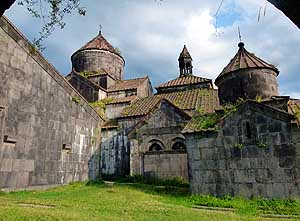
|
-
-
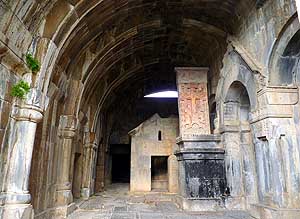
|
-
-
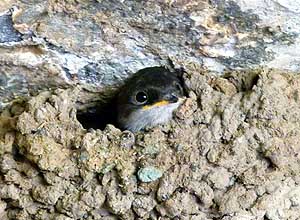
|
- 007
The northwestern corner of the
- Haghpat Monastery: Right „tower“
- St. Astvatsatsin Church; left ”tower“
- St. N'shan Church
|
- 008
Gallery and academy of the
- Haghpat Monastery. The cross stone
- on the plinth is called ”Amenaprkitch
- Khachkar” dating from 1273
|
- 009
A swallow peeks curiously from its
- earthy nest, built on a vaulted ceiling of an
- archway of the Haghpat Monastery.
- Ruins are a heaven for birds
|
| Our
first impression is that the landscape is hilly, green and densely
wooded. But there are also many rusty ruins of former Russian factories
standing around. The many pigs that are roaming around with their
offspring definitely show that we are in a Christian country again –
unthinkable in Azerbaijan. We follow the very potholed street along the Debed River with its many lay-bys. Unfortunately all of them are
rubbish-strewn. Soon we reach the turn off to the Akhtale Monastery,
situated on a hill. |
-
-
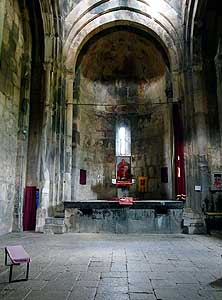
|
-
-
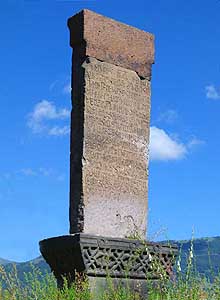
|
-
-
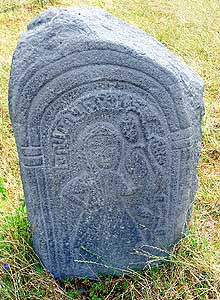
|
- A modest church altar and intricately elaborated cross stones are part
- of the spacious area of the Haghpat Monastery hidden behind thick walls
|
- 010
|
- 011
|
- 012
|
| The
ravages of time have left their traces at the outer walls of the 13th
century monastery. The interior, however, impresses with its well
preserved fine frescoes in strong colors, characteristic for the
Byzantine art. First, we are flirting with the idea of spending the
night at this remote peaceful spot, but then continue to the only 8
miles further lying Haghpat Monastery. Sitting on a lofty plateau on the
other side of the valley, it is praised as the "pearl of monasteries".
It belongs to the UNESCO World Heritage sites. |
-
-
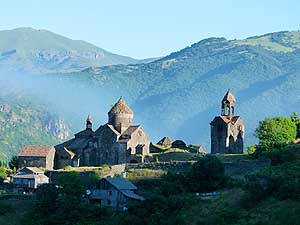
|
-
-
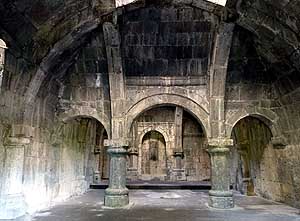
|
-
-
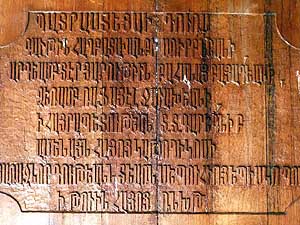
|
- 013
The first rays of the sun reach the
- Haghpat Monastery with its wonderful
- free standing belfry (right on the picture)
|
- 014
The dining hall in the service
- building along the northern wall
|
- 015
Stone inscriptions in Armenian
|
| The
sun is almost disappearing when we arrive. Immediately we realize that
this busy and uneven car park with the many souvenir shops is not
suitable as sleeping place. While we are on a brief discovery tour of
the site in the warm evening light, Maya and Wilfried from Germany turn
up with their Toyota Hilux. They are also on the lookout for a place to
spend the night. Quickly the two husbands are exploring the
possibilities and after a short bumpy ride across farm tracks they find
it. |
-
-
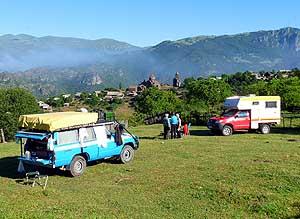
|
-
-
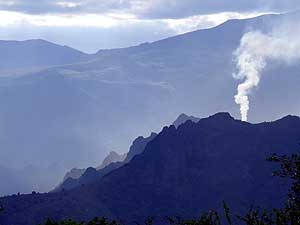
|
-
-
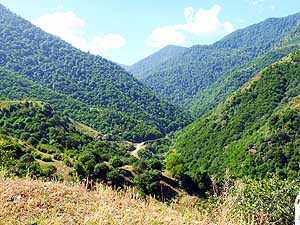
|
- 016
Emil is swapping tips with Maya
- and Wilfried from Germany. We
- camped together on a little meadow
- with view to the Haghpat Monastery
|
- 017
A still working factory from the
- Soviet era on the opposite side of the
- Debed Valley ejects stinking smoke
- into the sky. Today most of them are out
- of business and are just rusting away
|
- 018
Further down the "Monastery
- Road" dense mountain forests dominate
- the landscape of the Lori province
|
| It’s a
little flat meadow with a stunning view of the monastery. Soon some
unusual visitors turn up: First four grunting pigs and then two curious
horses. Frogs are croaking close-by. We feel wonderfully at ease! Maya
and Wilfried are also retired and travel a lot. Therefore we have plenty
to talk about. We only crawl into our warm sleeping bags when our limps
are almost stiff. It gets cold at night. We are at an altitude of about
3’300 ft. [1’000m]. |
-
-
-
-
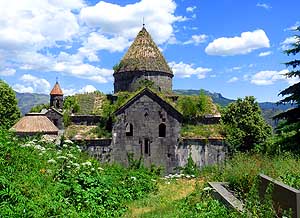
|
-
-
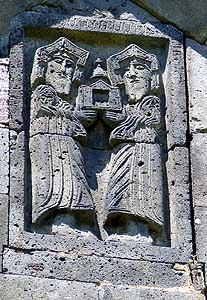
|
-
-
-
-
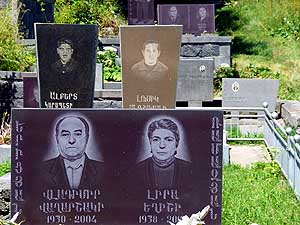
|
- 019
High over the Debed Valley, flanked
- with age-old huge trees lies the moss
- covered Sanahin Monastery with its
- century old gravestones. It is also a
- UNESCO World Heritage site .....
|
- 020
..... the relief of Smbat II Bagratuni,
- King of Armenia, and his junior brother
- Gurgen I, King of Lori that is cut into the
- dark walls spread a sense of vitality. A
- similar relief is in the Haghpat
- Monastery (pic #6) .....
|
- 021
..... in the overgrown cemetery
- there are fenced-in family tombs with
- pictures of the deceased
|
| Early
morning weird sounds are waking us up: Here they are again – the two
curious horses from last evening. They already roam around our
LandCruiser. Today a playful brown foal is among them. The grunting of
the pigs is not far away either. Time to rise! When we crawl out of the
car, the rising sun is just setting the mountain slope behind the
monastery ablaze. Shortly after, it also catches the Haghpat Monastery –
what a beautiful sight. With this stunning scenery and the sun warming
us we have breakfast and exchange our last travel tips with Maya and
Wilfried. Their time in Armenia is up. Today they leave the country for
Georgia. |
-
-
-
-
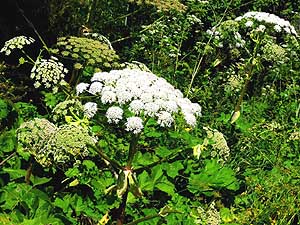
|
-
-
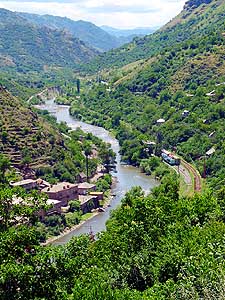
|
-
-
-
-
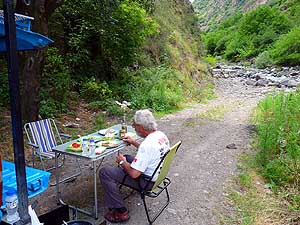
|
- 022
Chervil (Anthriscus cerefolium)
- like we remember it from back home,
- with the exemption that here it reaches
- an enormous size
|
- 023
The Debed River is meandering
- picturesquely through the narrow valley.
- The road that follows the river bed is the
- main artery linking the capitals of Yerewan
- in Armenia with Tbilisi in Georgia .....
|
- 024
..... near the stony riverbed we
- find a quiet spot for our lunch break
|
|
Haghpat merits to be called the "pearl of monasteries". Everything on
the widespread area behind the thick walls is well maintained: The free
standing clock tower, the churches, the fine reliefs and the intricately
carved cross stones. Just a few miles further down the “monastery road”
lies the third and the second monastery in a row belonging to the UNESCO
World Heritage Sites: The Sanahin Monastery. Together with us three tour
busses maneuver the narrow road uphill: ‘Studioso Explorers’, Koreans
and Russians. Souvenir shops besiege the entrance. A persistent
saleslady even speaks German. The moss-covered monastery, together with
its century old gravestones and huge old trees, looks almost spooky. So
does the overgrown cemetery with its fenced-in family graves. |
-
-
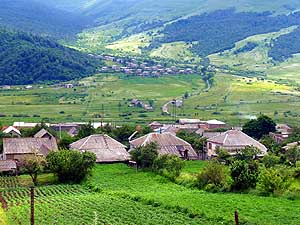
|
-
-
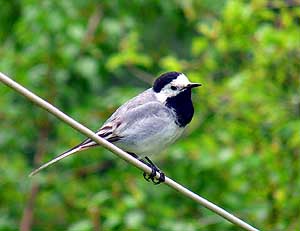
|
-
-
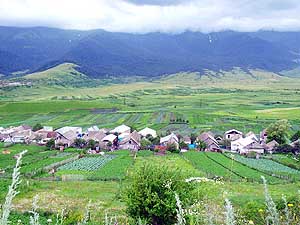
|
- 025
Between Vanadzor and Dilijan a
- fertile valley with vegetable cultivations
- is spreading near Lemontovo. Special
- looking are the deep corrugated iron
- roofs of the farmers houses .....
|
- 026
..... a white wagtail (Motacilla
- alba) observes the world from
- its perspective .....
|
- 027
..... the neatly divided vegetable
- fields and the straight farming village
- of Margahovit contribute to the
- peacefulness of the rural scene
|
| We
follow the Debed Canyon that is meandering picturesquely through the
narrow valley and picnic near the stony riverbed. Shortly after we are
in Vanazor – an ugly town with ugly department blocks and ugly potholed
roads. There, we turn off to the east, to Dilijan, also called
“Switzerland of Armenia”. It is a lovely drive along a fertile lush
green valley with vegetable cultivations and beautiful flowering
meadows. But our main goal is not the famous mountain resort. It is the
Haghartsin Monastery, which we reach through the forested Dilijan Nature
Reserve. The turn off is 4 miles [6km] east of town. After three miles
[5km] uphill on a new tarmac road, the first view of the “fairytale
monastery” appears. From the first moment we sight it, we are
captivated. |
-
-
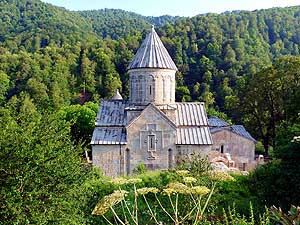
|
-
-
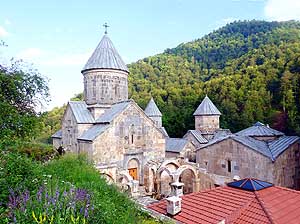
|
-
-
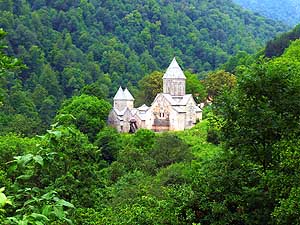
|
- 028
4 miles east of Dilijan a good tarmac
- road leads to the forested Dilijan Nature
- Reserve. After another 3 miles up it stands
- in front of us: The Haghartsin Monastery
- what means "Dance of the Eagles" .....
|
- 029
..... the monastery has three churches:
- For Gregory the Illuminator, for the Virgin
- Mary and the chapel of St. Stepanos.....
|
- 030
.....it is hidden away in a lovely
- forest valley and was built in the 12th century
- by two princes of the Bagratuni Kingdom
|
|
Surrounded by dense forest, its bright grey-white facade contrasts
beautifully with the dark trees. The setting is unique. We are tempted
to spend the night on the small even space at the end of the road. But
when again and again motorbikes rumble up and down, we decide to move to
one of the ‘hidden’ picnic spots of the Nature Reserve. The darker it
gets however, the more doubts are creeping on us if the place is safe.
We feel like in a mouse trap. Despite that night is falling, we return
to the main road and spontaneously follow the sign to the Hotel Tavush.
The manager, who speaks very well German, kindly allows us to sleep in
our car on his guarded parking area. |
-
-
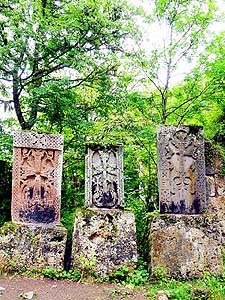
|
-
-
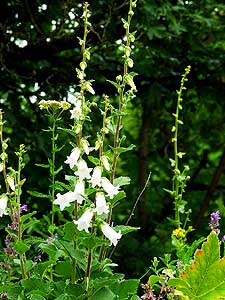
|
-
-
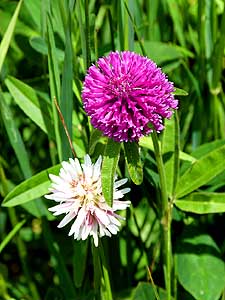
|
- 031
Close to the Haghartsin Monastery -
- in an overgrown forest area - are lovely
- medieval carved cross stones
|
- 032
Delicate white bells are one of the
- many flowers that bloom around the
- region of the Haghartsin Monastery .....
|
- 033
..... a pair of clover (Trifolium)
- flowers glows from the lush green
|
| It
rained heavily during the night and the forest is shrouded in mist.
Nonetheless we decide to drive uphill again and have breakfast at the
Haghartsin Monastery. While Emil is updating his statistics, I wander
around and discover so many beautiful flowers, still covered with
morning dew. The cute young ‘monastery dog’ follows me enthusiastically
wherever I go. And then the first flicker of sunlight engulfs the
monastery, boosting even more its fairytale appearance. |
-
-
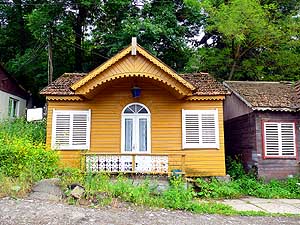
|
-
-
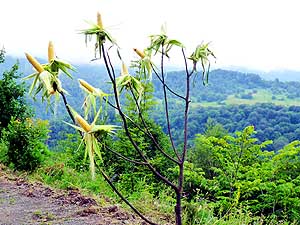
|
-
-
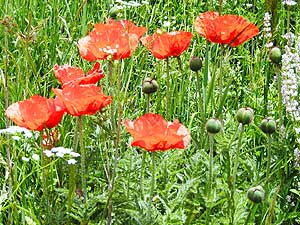
|
- 034
A cute gingerbread-style house in
- Dilijan. “Alpine” Dilijan is also called
- "Switzerland of Armenia". Here was also the
- main link between Armenia and Azerbaijan
- before the start of the 1988 war
|
- 035
No, also here corncobs don’t grow
- on trees! They are stuck on branches to
- draw the attention to the next street
- vendor of hot corncobs
|
- 036
Red papaver or oriental poppy
- (Papaver orientale) is widespread and
- attracts us in its intensive luminosity
- again and again to make a picture
|
| Slowly
we feel hungry, it is getting noon. In a restaurant at the main plaza in
Dilijan we both order an Armenian kebab with pommes and a huge Armenian
beer, the beer however not being really our taste. On the lookout for
the historical center of the city mentioned in Lonely Planet that seems
not to exist, two policemen approach us. Repeatedly they point to our
jerry cans on the roof rack. We play ‘dumb’ knowing that the two are
just looking for a reason to get some money. However they have to go
away empty-handed. |
-
-
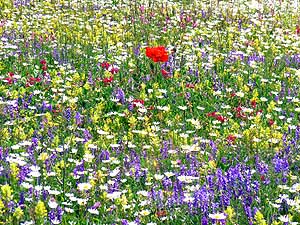
|
-
-
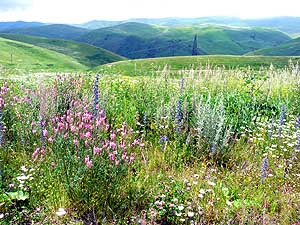
|
-
-
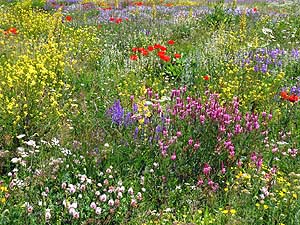
|
- On the old Sevan Pass road (6’936 ft.) from Dilijan to Lake Sevan the explosion of
spring hits us with full power.
- Wonderful carpets of flowers in white, red, lilac, yellow, pink and blue glow from all
sides – the variety of colors, species
- and combinations are endless. Each time we think it cannot get more beautiful, there is
another accumulation. It is a party
- for our senses. And we have all this beauty to ourselves, as people prefer the faster,
7’054 ft. long tunnel
|
- 037
|
- 038
|
- 039
|
| Being
already late afternoon, we decide to spend another night at the Tavush
Hotel, but this time in a room. We are the only guests and have the huge
living area just to ourselves. Until late we are working on our laptops
and right at the moment when we want to shut them down, to our joy the
car permit for Abkhazia arrives in the inbox. |
-
-
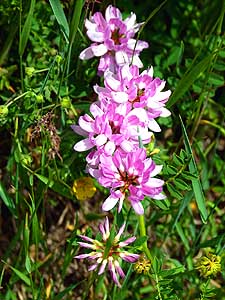
|
-
-
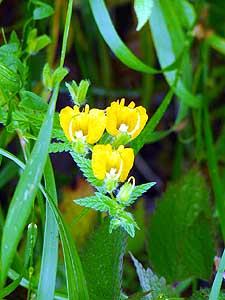
|
-
-
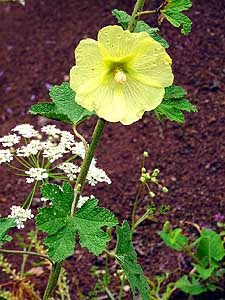
|
- We enjoy not only the endless seeming flower carpets but also the uniqueness
- of each delicate blossom that we discover on the Sevan Pass on the way to Lake Sevan
|
- 040
|
- 041
|
- 042
|
| Well
rested and freshly showered, we hit the road to the south, to Lake Sevan,
with 480 sq.mi. [1’242km²] being the biggest lake in the Caucasus
region, situated on an altitude of 6’234 ft. [1’900m]. Instead of taking
the 7'054 ft. [2’150m] long tunnel, we drive the old, longer 6'936 ft.
[2’114m] high mountain pass road. It proves to be lonely and very
beautiful. Springtime is literally in full swing. To the right and to
the left of the road alpine flower carpets extend in an incredible
diversity and combination of colors. |
-
-
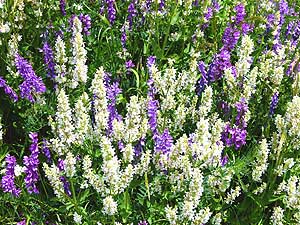
|
-
-
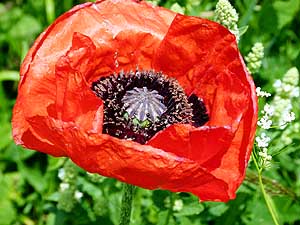
|
-
-
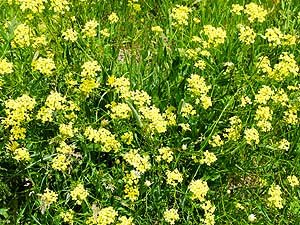
|
- The height of nearly 7’000 ft. of the Sevan Pass on the 22 miles long road from
Dilijan to
- Lake Sevan is almost a paradise for the growth of alpine flowers. We just cannot stop
taking pictures!
|
- 043
|
- 044
|
- 045
|
| One
carpet is more outstanding than the other – in white, red, lilac,
yellow, pink and blue. My enthusiasm never ceases and finally also Emil
gets bitten by the bug and both of us get into a real photographing
frenzy. When we think that it cannot get more beautiful, there is
another climax. No wonder that we spend more than three hours amid this
blooming splendor. Also for our picnic we cannot think of a more
wonderful place. Carpets of flowers are one thing that never fails to
amaze us. |
-
-
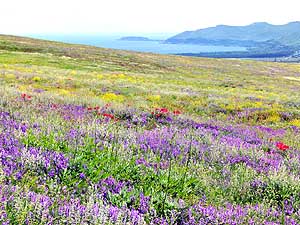
|
-
-
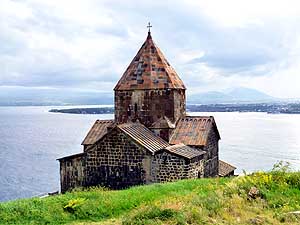
|
-
-
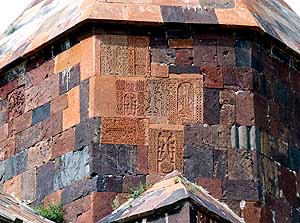
|
- 046
Across the carpets of meadows
- looms Lake Sevan. It lies on an altitude of
- 6’234 ft. above sea level and covers 363
- sq.mi., and is therefore the biggest lake in
- the Caucasus region. The fresh water lake
- supports a fish population including the
- "Ishkhan" (Salmo ischchan), the prince trout
|
- 047
The Sevan Monastery
- “Sevanavank” is situated 4 miles
- before the same-named village and
- offers a commanding view over the
- same-named lake .....
|
- 048
..... exquisitely chiseled
- ornaments decorate one of the
- ancient stone walls
|
| A
short descent and we roll along the Sevan lake shore to the Sevanank
Monastery. Fresh and smoked fish is sold in many places. On the parking
at the base of the monastery we are shocked by the masses of people. It
is more a must than a joy to climb up the many steps to the monastery
where souvenir sellers and their paintings occupy each corner. Apart
from the sea view and a few exquisitely carved ornaments on stonewalls
there is little to hold us. Back at the parking we have to argue with
the attendant. He wants AMD (Dram) 500 instead of 200. He insists that
we are a bus. We are not. He gets 200. |
-
-
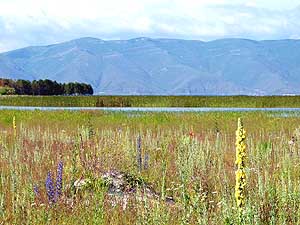
|
-
-
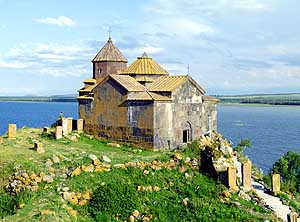
|
-
-
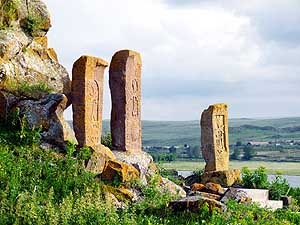
|
- 049
The marshland of the Sevan National
- Park does not attract the mass tourism that
- overruns the Sevan Lake during the ten
- weeks’ summer holidays
|
- 050
On a promontory 18 miles south
- of Sevan stands the 1100 years old
- Hayravank Monastery directly on the
- lakeshore, built of tuff stones that
- cover the landscape in this region .....
|
- 051
..... richly decorated "Khachkars"
- – cross stones from medieval times
- – line the stairs to the Hayravank
- Monastery
|
|
Quickly we leave touristic Sevan behind us. Along the Sevan National
Park with its peaceful marshland we reach the 1’100 year old Hayravank
Monastery, beautifully situated on a promontory at the lake shore. It is
built of tuff stones of the region, covered all over with rust-red
lichens. Richly decorated ‘khatchkars’ – cross stones from the medieval
times – rise towards a blue sky. It is an awesome sight! Nearby we spot
a grassy track leading through tuff stones uphill. |
-
-
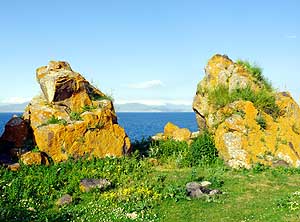
|
-
-
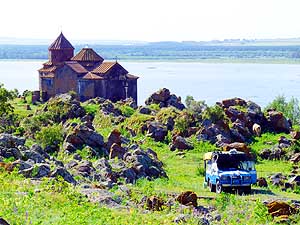
|
-
-
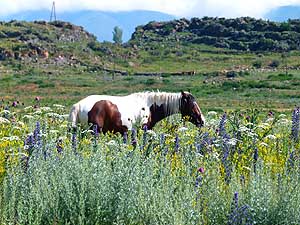
|
- 052
A lovely contrast: Tuff stones
- covered with rust-red lichens and the
- deep blue of Lake Sevan at the
- Hayravank Monastery
|
- 053
Our wild but romantic night spot with
- lake view between tuff stones near the
- Hayravank Monastery where thunder and
- lightening kept us awake until after midnight
|
- 054
Happy horse to be able to roam
- around freely in such a lovely place
|
| As
evening is approaching, we are flirting with the idea to camp in this
wild romantic surrounding. We engage 4x4 and follow the trace and soon
we find “our” place. We are just sitting peacefully outside, when in
short intervals lightning strikes and thunder rumbles. A dark
storm front is racing towards us. In record time we pack up and make our
bed – not a moment too soon before the sky opens its sluices. The
thundering does not stop well past midnight. Only then we are able to
get some sleep. |
-
-
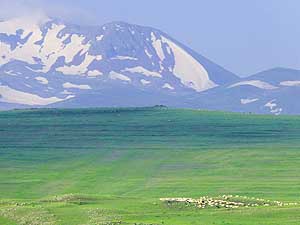
|
-
-
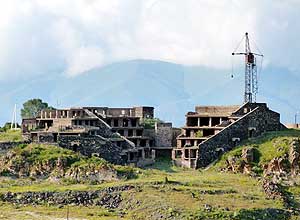
|
-
-
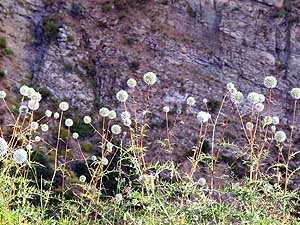
|
- 055
Snow patches still cover parts of
- the 11’800 ft. high Azhdahak mountains
- west of Lake Sevan, which is situated
- itself already on an altitude of 6’234 ft.
|
- 056
This is not an isolated case: An
- unfinished building including crane from the
- Soviet time at Lake Sevan's shore. It should
- have become a hotel, but the money supply
- was cut off due to the war with Azerbaijan
- and it is left now to its destiny
|
- 057
Globe thistles (Echinops
- sphaerocephalus) that look especially
- lovely against a dark rock
|
| The
nightly thunderstorm cleared the skies and opened up the view to the
11'800 ft. [3'597m] high Azhdahak snow mountain. An old bearded man is
herding his cattle past our breakfast table, and then we are alone
again. It becomes mid-morning until we break our camp and head to our
next destination: To the big concentration of middle aged stone crosses
of Noratus that spread around a huge area. There are said to be 800,
carved between the 9th and 17th century. Knitters, mostly of
old age, are sitting between the fine elaborated medieval stones. They
are trying to sell their handmade gloves and beanies. |
-
-
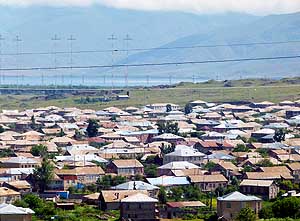
|
-
-
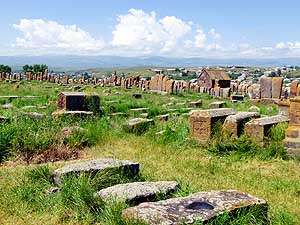
|
-
-
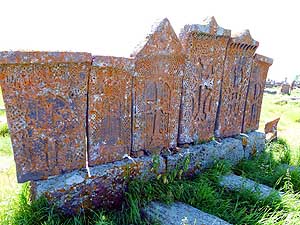
|
- 058
A bit southwest of the Hayravank
- tuff monastery lies the village of Noratus,
- famous for its ancient headstones, called
- "Khachkars", which are characteristic
- of medieval Christian Armenian art
|
- 059
The cemetery on the east side
- of the village is studded with over
- 800 headstones and graves, which
- were carved between the
- 9th and 17th century .....
|
- 060
..... and show all kind of
- wonderfully elaborated motifs
|
|
Following once more the lake shore, we drive to Marturi, where we take
the good tarmac road to the 7’907 ft. [2’410m] high Selim Pass. A
beautiful tundra-like landscape recalling Inuvik in Canada, and
long-stemmed golden flowers along the road highlight our climb. The
mountain pass holds two surprises: A far reaching panorama and the old
Selim Caravanserai where in earlier times caravans stopped on their
“Silk Road” trade route. We are not stopping for long, but start the
many switchbacks descent down to the Arpa River valley. With each mile
we drive, the hotter it gets. At lunch time we are seeking already the
shade of our LandCruiser. |
-
-
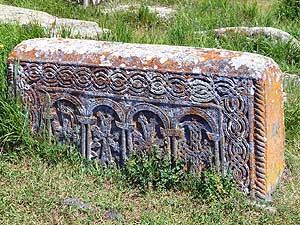
|
-
-
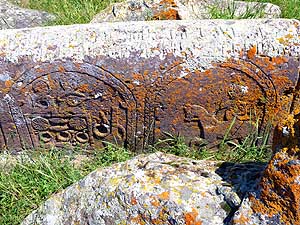
|
-
-
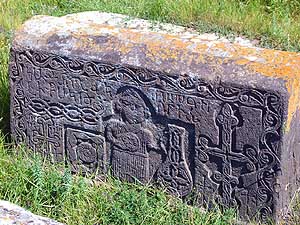
|
- Besides the hundreds of cross stones there are also grave stones with fine details at
Noratus dating from the 1st and 2nd century:
|
- 061
Crosses with different engravings
|
- 062
A herdsman on a horse
- and a musician on a chariot
|
- 063
A woman in front of a water jar (?)
|
|
Reaching Shatin we spontaneously decide to make a detour to Yeghegis. It
leads us through a narrow stunning river valley, framed by high mountain
peaks. Apricots and walnuts grow in the fertile valley. The apricots are
in full season and hang heavily from bending branches. Many have already
dropped to the ground. Then we stop and get some if birds have not
already feasted on them. There is also an 800 year’s old overgrown
Jewish cemetery with a few tombstones with Hebrew inscriptions. The
oldest grave dates from 1266 and the newest from 1346. It is still a
mystery about the appearance and disappearance of the Jewish community. |
-
-
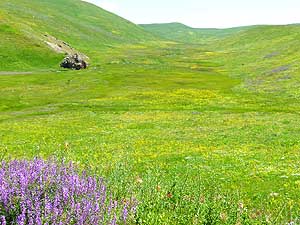
|
-
-
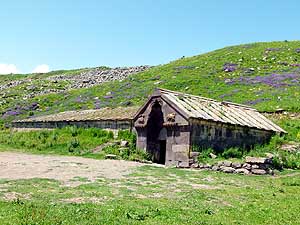
|
-
-
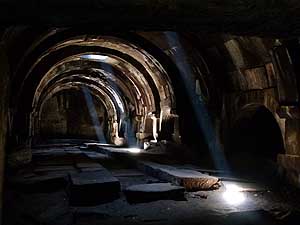
|
- 064
Recalls the Canadian tundra on the
- way to Inuvik in the Northwest Territories:
- Landscape south of Martuni at the north side
- of our ascent to the 7’907 ft. high Selim Pass
|
- 065
On the 7’907 ft. high Selim Pass is
- the old Selim Caravanserai where in earlier
- times caravans stopped on their “Silk Road”
- trade route over the Geghama Ridge .....
|
- 066
..... the interior of the Caravanserai
|
| There
are enough churches and monasteries in this region. One of the old
monasteries is Arates, reachable by a good tarmac road from the village
of Hermon. Past dilapidated huts we climb higher and higher towards the
mountains. Almost on the top, where the mountain peaks meet the blue
sky, we are there. Disappointment takes over. It this all what is left
from the former glory of the three churches from the 7th and 13th
century? It looks like! |
-
-
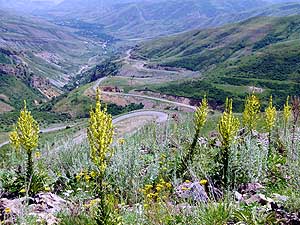
|
-
-
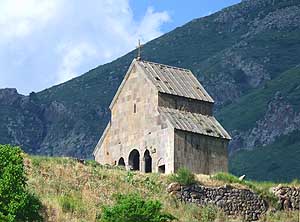
|
-
-
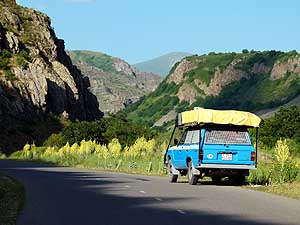
|
- 067
A nicely paved road with many
- switchbacks leads from the Selim Pass
- down to the Arpa river valley. With
- each mile it gets warmer
|
- 068
Halfway between Selim Pass and
- Arpa Valley we make a side trip from
- Shatin to the Yeghegis Valley which is
- famous for its concentration of churches.
- Here the Zorats Church dating from
- 1303 near the village of Yeghegis
|
- 069
The Yeghegis Valley surprises
- with a beautiful mountain scenery and
- apricot and walnut plantations
|
| The
site is crumbled and overgrown; the stone crosses are covered with moos.
"Be careful, I am sure there are snakes", I remind Emil, when we step
through the high grass into the moldy inner walls. Apart from a wall
with strange inscriptions, nothing survived. But we do see a snake, a
red-brown one. It rushes right past Emil's feet and disappears under a
stone. Despite of the disappointing site, the drive was well worth it.
On an overgrown track below the ruins we find in total solitude a
beautiful camping spot with a far view towards green hills. We are on an
altitude of 5'900 ft. [1’800m]. |
-
-
-
-
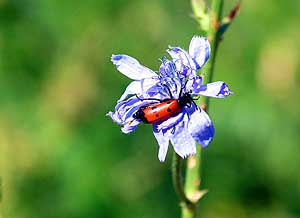
|
-
-
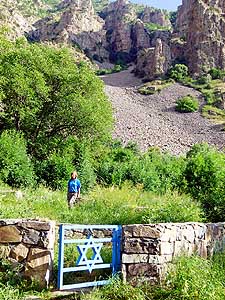
|
-
-
-
-
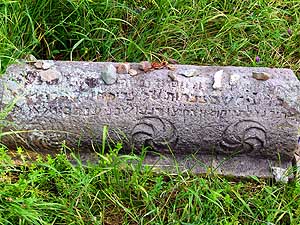
|
- 070
Discovering a shining beetle on a
- flower is always an enjoyable moment
|
- 071
Close to Yeghegis village hides an
- 800 year old overgrown Jewish cemetery
- behind a metal door on the south side of
- the river. Where the Jewish community
- arrived from and why it disappeared
- again remains still a mystery .....
|
- 072
..... the tombstones with Hebrew
- inscriptions show biblical verses and
- names of the deceased. The oldest dates
- from 1266 and the newest from 1346
|
| The
humming of bumblebees and the chirping of birds surround us at
breakfast. We return to the road M10, and drive then continuously on M2
eastwards on a miserably potholed road, all in 2nd gear. In return, the
landscape with its white, lilac, pink and yellow flower carpets is a
feast for the eyes. The splendor of spring accompanies us already since
Iran, Turkey,
Georgia and Azerbaijan, and now also in Armenia. Who else
was able to enjoy such a long-lasting springtime through five countries? |
-
-
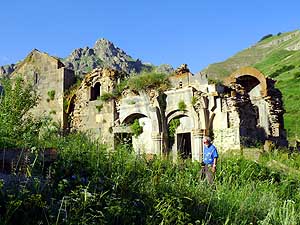
|
-
-
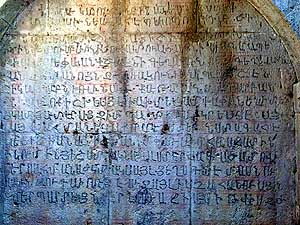
|
-
-
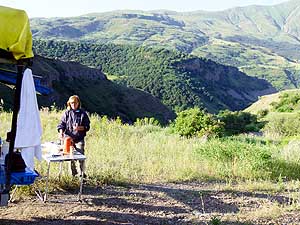
|
- 073
Up the mountain from the village
- of Hermon sits the Arates Monastery with
- three churches from the 7th and 13th century.
- There is not much left of the beauty except
- the lovely mountain setting .....
|
- 074
..... the wall with inscriptions is
- one of the only pieces that survived
|
- 075
Liliana prepares breakfast. We
- camped on an overgrown track below
- the monastery ruins of Arates at an
- altitude of 5’900 ft
|
- Continuation to the next Armenian page:
Armenia Part 2
– July 19 to 22, 2013, from Nagorno-Karabakh
to Georgia
Part 2b
|
-
- The "Greater"-Middle East trip 2012/13:
- Sharjah/Dubai/1st Traveler's Festival/Emirates
National Auto Museum - UAE with
car Nov. 2012 to Jan. 2013 - part 1
- Western UAE - Liwa - United Arab Emirates with car in January 2013 - part 2
- Oman 2013 - Part 1 - February
2013: Musandam Peninsula
- Oman 2013 - Part 2 - February
2013: Sohar - Muscat - Rustaq - Nizwa
- Oman 2013 - Part 3 - March
2013: Sur - East Coast - Island of Masirah - Dhofar
- Oman 2013 - Part 4 - March
2013: Salalah & Surroundings (Dhofar) - Nizwa
- Oman 2013 - Part 5 - March 2013: Western Hajar
Mountains
- Al Ain, Eastcoast & Ras al Khaima - United
Arab Emirates with our car in April 2013 -
part 3
- Iran -
Part 1: Ferry Port Bandar Abbas-Shiraz-Persepolis-Pasargad (between Persepolis and Yazd)
– May 2013
- Iran -
Part 2: Pasargad
(excl.)-Yazd-Esfahan – May 2013
- Iran -
Part 3: Esfahan
(excl.)-Chelgerd-Hamadan-Sanandaj-Orumiyeh-Turkey Border
– May 2013
- Turkey: Iran Border-Esendere-Hakkari-Van-Doğubayazıt-Kars-Ardahan-Hopa-Georgia
Border – May/June 2013
- Georgia -
Part 1: Turkey Border-Ajaria-Gori-Tbilisi-Kakheti-Azerbaijan
Border – June 2013
- Azerbaijan: Georgia Border-Balakən-Şəki-Lahıç-Baku-Xınalıq-Quba-Laza-Baku-Gəncə-Georgia Border – June 2013
-
Georgia - Part 2a: Azerbaijan Border-Tbilisi-Armenia
Border –
June/July 2013
- Nagorno-Karabakh:
Armenia-Stepanakert-Gandzasar-Martakert-Tigranakert-Tnjri-Shoushi-Armenia – July
- Armenia -
Part 2:
Nagorno-Karabakh-Goris-Tatev-Noravank-Khor Virap-Echmiadzin-Yerewan-Geghard-Gyumri-Georgia Border – July 2013
- Georgia -
Part 2b: Armenia Border-Ninotsminda-Tbilisi-Mtskheta-Kazbegi-Kutaisi-Zugdidi –
July 2013
- Georgia -
Part 3a:
Zugdidi-Swaneti-Zugdidi-Abkhazia Border – July/August 2013
- Abkhazia: Georgia-Sukhumi-Tsebelda-Novyy Aton-Lake
Ritsa-Gagra-Pitsunda-Georgia – August
2013
- Georgia - Part 3b: Abkhazia Border-Poti-Ferry to Ilyichevsk/Ukraine
– August 2013
|
|
|
![]()
